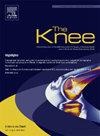股骨远端变曲截骨矫正和铰链宽度对铰链骨折的影响:猪股骨生物力学研究。
IF 1.6
4区 医学
Q3 ORTHOPEDICS
引用次数: 0
摘要
背景:股骨远端截骨术(DFO)中产生的变位铰链骨折会导致轴向和扭转稳定性下降。本研究旨在评估:(1)在股骨远端截骨术(DFO)中,外侧开放楔形截骨术(LOW)和内侧闭合楔形截骨术(MCW)哪种铰链宽度发生铰链骨折的风险较高;(2)哪种截骨术可在发生骨折风险前进行较大程度的矫正;(3)患者特异性器械(PSI)是否可准确规划铰链宽度:将 30 块猪股骨分为两组:方法:将 30 块猪股骨分为两组:LOW 组、MCW 组(铰链宽度分别为 5 毫米、7.5 毫米和 10 毫米)。以 PSI 导航方式进行截骨。在单轴试验机中施加平行于纵向骨轴的力,直至发生骨折:LOW和MCW的最大矫正角度分别为6.7 ± 1.1°和13.4 ± 1.9°(β0 , β1 = 0.002, β2 = 0.02, β3 = 0.005)。计划铰链宽度与实际铰链宽度的相对误差,LOW 为 -3.7 ± 12.3% (P = 0.25),MCW 为 12.3 ± 13.1% (P = 0.003):结论:在MCW截骨术中,增加铰链宽度可获得更大的矫正效果。对于 LOW 截骨术,较小的铰链宽度似乎更有优势,因为它可以在不产生铰链断裂风险的情况下实现更大的矫正。与MCW截骨术相比,PSI引导下的LOW截骨术可以在术中更准确地达到计划的铰链宽度。然而,当需要较大的矫正时,MCW截骨术似乎是首选,因为它可以实现较大的矫正角度,而不会有术中铰链骨折的风险。本文章由计算机程序翻译,如有差异,请以英文原文为准。
Influence of varus-producing distal femur osteotomy correction and hinge width in relation to hinge fractures: Biomechanical study on porcine femora
Background
Hinge fractures in varus-producing distal femoral osteotomies (DFOs) lead to decreased axial and torsional stability. The purpose of this study was to assess (1) which hinge width has a high risk of hinge fracture in DFO for lateral opening wedge (LOW) and medial closing wedge (MCW) osteotomies, (2) which osteotomies allow for greater correction before risking a fracture, (3) whether patient-specific instrumentation (PSI) allows accurate hinge width planning.
Methods
Thirty porcine femoral bones were divided into two groups: LOW, MCW with hinge widths of 5 mm, 7.5 mm, and 10 mm as subgroups. Osteotomies were performed in a PSI-navigated fashion. A force parallel to the longitudinal bone axis was applied in a uniaxial testing machine until a fracture occurred.
Results
The maximum correction was 6.7 ± 1.1° for LOW and 13.4 ± 1.9° for MCW (β0 < 0.001, β1 = 0.002, β2 = 0.02, β3 = 0.005). The relative error of the planned hinge width compared with the actual hinge width was −3.7 ± 12.3% for LOW (P = 0.25) and 12.3 ± 13.1% for MCW (P = 0.003).
Conclusions
Increasing the hinge width allows for greater correction in MCW osteotomies. For LOW osteotomies, a smaller hinge width seems to be advantageous because it allows a greater correction without the risk of hinge fracture. With PSI-guided LOW osteotomies, the planned hinge width could be achieved intraoperatively with greater accuracy than with MCW osteotomies. However, the MCW osteotomy appears to be the preferred option when larger corrections are desired because a larger correction angle can be achieved without the risk of intraoperative hinge fracture.
求助全文
通过发布文献求助,成功后即可免费获取论文全文。
去求助
来源期刊

Knee
医学-外科
CiteScore
3.80
自引率
5.30%
发文量
171
审稿时长
6 months
期刊介绍:
The Knee is an international journal publishing studies on the clinical treatment and fundamental biomechanical characteristics of this joint. The aim of the journal is to provide a vehicle relevant to surgeons, biomedical engineers, imaging specialists, materials scientists, rehabilitation personnel and all those with an interest in the knee.
The topics covered include, but are not limited to:
• Anatomy, physiology, morphology and biochemistry;
• Biomechanical studies;
• Advances in the development of prosthetic, orthotic and augmentation devices;
• Imaging and diagnostic techniques;
• Pathology;
• Trauma;
• Surgery;
• Rehabilitation.
 求助内容:
求助内容: 应助结果提醒方式:
应助结果提醒方式:


